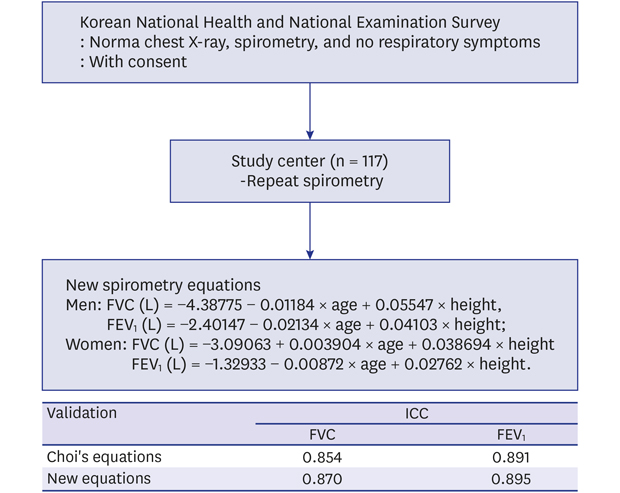1. Miller MR, Hankinson J, Brusasco V, Burgos F, Casaburi R, Coates A, et al. Standardisation of spirometry. Eur Respir J. 2005; 26(2):319–338.
2. Pellegrino R, Viegi G, Brusasco V, Crapo RO, Burgos F, Casaburi R, et al. Interpretative strategies for lung function tests. Eur Respir J. 2005; 26(5):948–968.
3. Hankinson JL, Odencrantz JR, Fedan KB. Spirometric reference values from a sample of the general U.S. population. Am J Respir Crit Care Med. 1999; 159(1):179–187.
4. Quanjer PH, Stanojevic S, Cole TJ, Baur X, Hall GL, Culver BH, et al. Multi-ethnic reference values for spirometry for the 3–95-yr age range: the global lung function 2012 equations. Eur Respir J. 2012; 40(6):1324–1343.
5. Crapo RO, Morris AH, Gardner RM. Reference spirometric values using techniques and equipment that meet ATS recommendations. Am Rev Respir Dis. 1981; 123(6):659–664.
6. Roca J, Sanchis J, Agusti-Vidal A, Segarra F, Navajas D, Rodriguez-Roisin R, et al. Spirometric reference values from a Mediterranean population. Bull Eur Physiopathol Respir. 1986; 22(3):217–224.
7. Choi JK, Paek D, Lee JO. Normal Predictive values of spirometry in Korean Population. Tuberc Respir Dis (Seoul). 2005; 58(3):230–242.
8. Morris JF, Koski A, Johnson LC. Spirometric standards for healthy nonsmoking adults. Am Rev Respir Dis. 1971; 103(1):57–67.
9. Hwang YI, Kim EJ, Lee CY, Park S, Choi JH, Park YB, et al. Application of a new spirometric reference equation and its impact on the staging of Korean chronic obstructive pulmonary disease patients. Yonsei Med J. 2012; 53(2):363–368.
10. Eom SY, Kim H. Reference values for the pulmonary function of Korean adults using the data of Korea National Health and Nutrition Examination Survey IV (2007–2009). J Korean Med Sci. 2013; 28(3):424–430.
12. Hwang YI, Park YB, Yoon HK, Lim SY, Kim TH, Park JH, et al. Development of prediction equation of diffusing capacity of lung for Koreans. Tuberc Respir Dis (Seoul). 2018; 81(1):42–48.
13. Crapo RO, Morris AH, Gardner RM. Reference spirometric values using techniques and equipment that meet ATS recommendations. Am Rev Respir Dis. 1981; 123(6):659–664.
14. Sim YS, Lee JH, Lee WY, Suh DI, Oh YM, Yoon JS, et al. Spirometry and bronchodilator test. Tuberc Respir Dis (Seoul). 2017; 80(2):105–112.
15. Oh YM, Hong SB, Shim TS, Lim CM, Koh Y, Kim WS, et al. Effect of a new spirometric reference equation on the interpretation of spirometric patterns and disease severity. Tuberc Respir Dis (Seoul). 2006; 60(2):215–220.
16. Hwang YI, Park YB, Yoo KH. Recent trends in the prevalence of chronic obstructive pulmonary disease in Korea. Tuberc Respir Dis (Seoul). 2017; 80(3):226–229.
17. Park SY, Kim JH, Kim HJ, Seo B, Kwon OY, Chang HS, et al. High prevalence of asthma in elderly women: findings from a Korean national health database and adult asthma cohort. Allergy Asthma Immunol Res. 2018; 10(4):387–396.
18. Ministry of the Interior and Safety. Resident registration demographics. Updated 2013. Accessed September 12, 2019.
http://27.101.213.4/index.jsp.










 PDF
PDF Citation
Citation Print
Print




 XML Download
XML Download